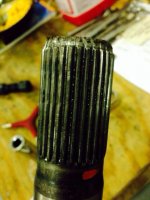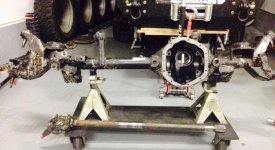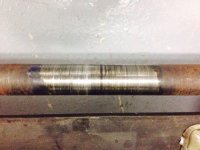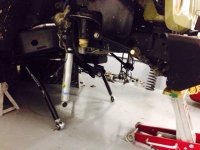jedg
New member
If it were me, I would make sure they are set to the same length - just in case.
Got it. Thanks a bunch! Still waiting for MoTech to finish with it. I may ask if they would correct this for me since it's there right now.
If it were me, I would make sure they are set to the same length - just in case.
Cam bolts are a terrible solution for caster adjustment and adjustable ball joints will only help correct "camber" which is NOT the same thing and if you have it, you most likely have bent c's.
Not arguing your comment in any way Eddie, but correct me if I'm wrong. Caster can be adjusted with adjustable ball joints, but in turn, camber will be affected. So adjustable ball joints should only truly be used to adjust camber not caster. The only reason you SHOULD use them to adjust camber is if your C's are bent. Which if that's the case, you'd have bigger problems.
I am sorry but on a solid axle, ball joints will not be able to adjust caster - only camber. Caster is set by rotating the pinion down for a greater positive setting and vice versa. Cam bolts or adjustable control arms are the only way you can adjust caster. Adjustable ball joints are only capable of adjust camber.
Ok, I've never installed a set of adjustable ball joints, I thought they spun 360 degrees. I know on Ford 3/4-1 ton trucks with straight axles, you can install a set of cam bushings that do spin 360 degrees which allow you to adjust both camber and caster, you just have to find a happy medium not to favor one too much more than the other. I just thought adjustable ball joints worked the same. Learned something new
I know one guy who used adjustable ball joints for caster.
Yeah, that's about how the adjustable ball joints work and I suppose you could get them to adjust for a bit of caster as well so long as you do find a happy medium but on a Jeep, there really is no sense in trying to do it this way. For one, most adjustable ball joints only allow for about a degree of correction and for two, adjustable control arms do a much better job and is a lot easier. Ideally, adjustable front lower arms are used to set your axle position and then adjustable uppers set caster.
Yes but with the stock housing caster takes a back seat to pinion with 4+
So let's say the jeep has 4" of lift and 1* caster angle. 1-1.5 maybe the max running a aftermarket driveshaft.
I see a lot of guys running 3/3 or even 2/4 to limit DS vibes. A huge benefit with a Prorock housing is increased caster/pinion separation. 10-11* I believe over the stock 6*
Yes but with the stock housing caster takes a back seat to pinion with 4+
So let's say the jeep has 4" of lift and 1* caster angle. 1-1.5 maybe the max running a aftermarket driveshaft.
I see a lot of guys running 3/3 or even 2/4 to limit DS vibes. A huge benefit with a Prorock housing is increased caster/pinion separation. 10-11* I believe over the stock 6*




A lesson was learned last night about the lock sensor (plunger). This bastard has be installed before the ring gear goes in, that is all.
View attachment 105438
Good that you caught it before you sealed it up and went to use it.
